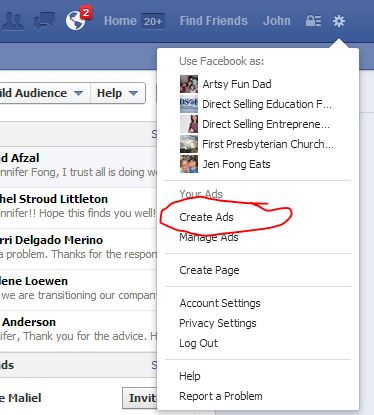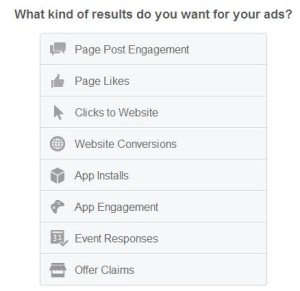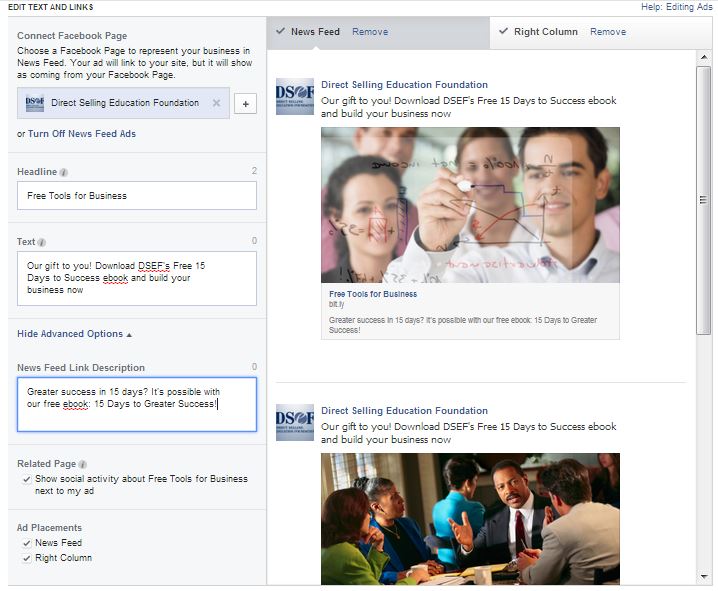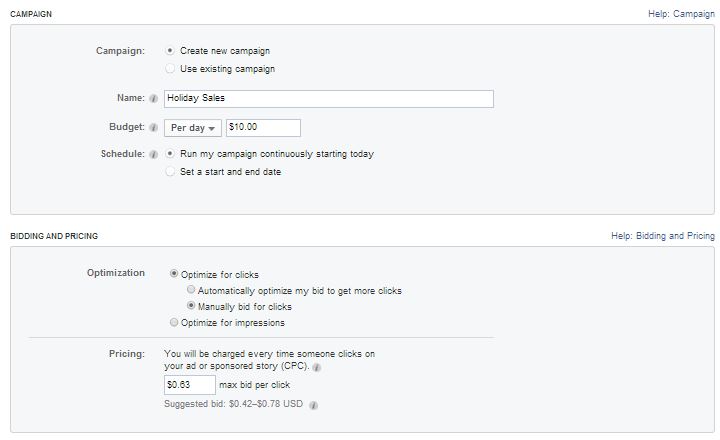Facebook Ads can be a powerful tool in helping you build business during the holidays. For a rather small investment, you can specifically target people you want to reach with your message. Whether your message be related to sales or recruiting, Facebook Ads can help you reach the right people and build your business.
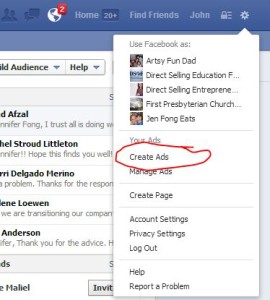 The easiest way to get started with Facebook Ads is to use Facebook’s built-in Ads Manager. To get there, click the wheel icon in the upper-right corner of any page on Facebook, and click Create Ads.
The easiest way to get started with Facebook Ads is to use Facebook’s built-in Ads Manager. To get there, click the wheel icon in the upper-right corner of any page on Facebook, and click Create Ads.
Next, you’ll choose an objective for your ad. If your goal is to increase the Likes on your Facebook Page so that you can build your community and engage them through a series of posts filled with content as well as promotions, choose “Page Likes.” You might choose “Clicks to Website” if you want to point your ad towards a sales or recruiting page on your site, or a custom landing page designed to capture visitor information. If you are going to be hosting a special event for the holidays (an open house, a table at a bazaar, etc.) you might want to choose Event Responses, and set up an Event on Facebook with the details of the event. If you’ve set up a special Offer on Facebook, such as a special discount on a product, you might choose Offer Claims. Choose the type of result you want for your ads, and select the objective from the list.
Once you’ve made your choice, select the options that make sense for you. In this case, we’ve chosen Clicks to Website. Note that we are adding additional tracking by using bit.ly (a link tracking service) that will enable us to count the number of clicks that our link gets. (For advanced users, you can use Google’s URL builder in conjunction with Google Analytics to track the source and medium of your links, and tie it to specific campaigns that you can track within Google Analytics. Shorten the tracking URL that the URL builder creates with bit.ly, and use that URL here.)
Next you’ll choose images for your ads. You can select up to 6 images, and Facebook will create up to 6 versions of your ad with each of the images.
Now it’s time to write your ad. Connect your Facebook Page to your Ad, and then write your ad copy. (Depending on the type of ad you choose, you may have slightly different options here.) You can choose to place your ad in the News Feed, the Right Column, or both. By default both are selected. If, for example, you want to remove the Right Column, simply select “Remove.” For tips on creating your Facebook Ads, read this post. (Facebook has recently changed its ads interface, but this post still has some useful information.)
Your next step is to make choices about who you want to target with your ads. You can choose geographic location, gender, age, interests and more. If your advertising budget is limited ($5 or $10 per day) try to keep your advertising target market small. You may also wish to target people whose friends are connected to your Page, as they may be more likely to engage with your ad because their friends already like you.
Targeting is the most important part of the ad process. Especially if your budget is small, be very specific about the type of people you want to reach. You may wish to limit your geographic area to where you actually live and can service customers, and be very specific about the interests, education level, etc. of the people you want to reach. If you’ve never done an ideal customer profile, now is the time to start. What does your most profitable target look like? What are their interests? What is their lifestyle? The more specific you can be, the more likely it is that you will reach them through your ad campaign. Experiment with this to see which target markets give you the best results.
Your final 2 steps involve creating a campaign and deciding how you will pay for your ads. Now mind you, you must have a billing source associated with your Facebook profile (personal account) in order to advertise.
First you’ll create a Campaign with a daily dollar limit associated with it. For example, you might create a campaign called “Holiday Sales” and add a daily spend limit of $10 per day for that campaign. All the ads you create will be lumped together under this campaign. You can create as many ads as you want for the campaign, but you will never spend more than $10 daily for this campaign. Once you reach that spend limit, Facebook will no longer display any of your ads that day.
Next you’ll decide how much you want to pay for your ads. If you Optimize for clicks, you’ll only get charged for the number of people that click on your ad. This is our favorite method. If you Optimize for impressions, you get charged for the number of times Facebook displays your ad, regardless of whether or not someone interacts with your ad.
You may want to choose “Manually bid for clicks” and then enter a dollar amount you’re willing to pay up to for clicks. Keep in mind that this is a bid, not a set amount. You will never pay more per click than the amount you specify, but you may pay less. Facebook recommends a range for your pricing bid. If you want to ensure your ad is displayed, you may want to work on the high side of this bid.
After you have made these choices, review and place your order. Once Facebook approves your ads (can take up to 24 hours) they will begin to run within the Facebook platform. It is important to continually monitor the success of your ads, and write new ones as needed.
Facebook Ads can be an excellent way to build your holiday business by helping you connect with more people. Start with a small daily amount, and monitor the success of your ads daily. This can be an excellent way to grow your business.
Do you use Facebook Ads? How successful have they been for you? What advice would you give to someone trying them for the first time? Would love to read your experiences in the comments below!


